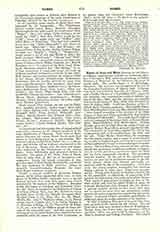

Names of Jesus and Mary, Sisters of the Holy, a religious congregation founded at Longueuil, Quebec, December 8, 1844, under the patronage of Bishop Bourget, of Montreal, for the Christian education of young girls. The motherhouse is at Hochelaga, Montreal. The institute was incorporated by Act of the Canadian Parliament, March 17, 1845. A Decree cum laude was issued by Pius IX, February 27, 1863, and a further Decree of September 4, 1877, approved the institute; the constitutions received definite approval June 26, 1901, and the institute was divided into seven provinces, May 11, 1894, later increased to nine, August 25, 1910. Under the direction of Rev. J. Allard three Canadian aspirants Miss Eulalie Durocher, Miss Henriette Cere, and Miss Melodie Dufresne—were trained according to the institute of the Holy Names of Jesus and Mary established by Msgr. Eugene de Mazenod of Marseilles. They took simple religious vows at Longueuil, December 8, 1844, as Sisters Marie Rose, Marie Madeline, and Marie Agnes. Bishop Bourget gave the institute diocesan approval and appointed Mother Marie Rose, general superior for life. The community at Marseilles supplied the title of the congregation and, with modifications, the habit and the rule. Under Mother Marie Rose, the congregation developed rapidly, and a course of study providing equally for English pupils and French was sketched on lines sufficiently broad to cover subsequent requirements. The teaching of boys was not at first contemplated, but missionary conditions rendering it imperative in certain provinces, permission from the Holy See has been temporarily obtained. The postulate lasts six months. At the end of the canonical year novices are sent for six additional months to the different houses, where they become practically acquainted with the life of the community. After five years, the young religious reconsiders her vocation during a retreat of thirty days. Final vows are perpetual. Young girls desirous of leading a hidden life in the apostolate of education, or possessing little aptitude for instruction, may enter as auxiliary sisters. Their spiritual preparation is similar to that of the choir sisters, and save for minor details in dress, no outward distinctions exist between the two classes. A general superior elected for five years, who may not be chosen for more than two consecutive terms, governs the entire congregation, assisted by four councillors. A general chapter assembles periodically to deliberate upon the major concerns of the institute.
In 1859 Archbishop Blanchet of Oregon City, Oregon, secured twelve sisters for his diocese. Several years later, they were invited to Seattle, Washington. Today these two States form one province, with a novitiate (1871) and provincial headquarters at St. Mary’s Academy and College, Portland. This school was empowered to confer degrees (July, 1893), also to grant a Teachers’ State Certificate good for five years, and a Teachers’ State Diploma qualifying the holder for life. In 1907, an Act of the Washington State Legislature, afterwards ratified by the State Board of Education, accredited the Holy Names’ Academies at Seattle and Spokane, as State Normal Schools. Two other provinces are located in the United States. That of California, established at Oakland (1868) by Bishop Alemany, possesses a novitiate since 1871; the New York province includes Florida. Quebec has four provinces; Ontario, one; Manitoba, one. Attached to Ontario are parochial schools in Detroit and Chicago. St. Mary’s, Portland, opened (1860) a refuge for destitute and orphaned children and still conducts a Home for Orphan Girls. The congregation numbers (1910) professed sisters, 1257; novices, 110; postulants, 81. It conducts 99 schools, residential, select, and parochial, attended by 24,208 pupils. Of these establishments, 48 are in the United States.
MARIE R. MADDEN

